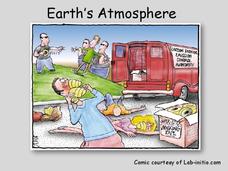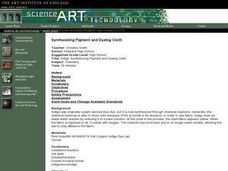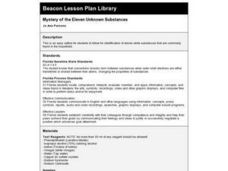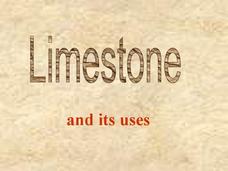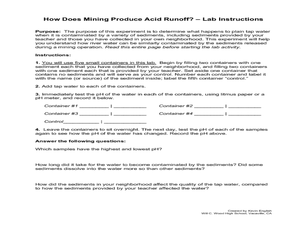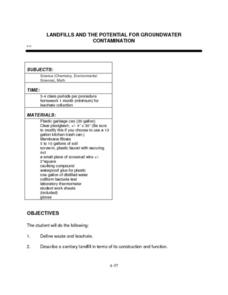Science Geek
Earth's Atmosphere
Ozone gas absorbs the harmful UV-B rays and helps protect humans. An informative presentation begins with the layers of the earth's atmosphere, the pressure and temperature in each of the layers, the ozone layer, the ozone cycle, and the...
Curated OER
Microscopes and Crystals
Students observe crystals under the microscope. In this science lesson, students compare how the crystal look like using their eyes, hand lens and microscope. They identify the type of crystal based on the amount of light they allow to...
Curated OER
Sink or Swim
Students define density and explain how to determine the density of an object. Students participate in a demonstration that shows the differences in the densities of different liquids and how they affect the liquid's physical properties.
Curated OER
Lotic Environment
Students assemble a classroom river model as an example of a lotic system. They control and measure biotic and abiotic information for the in-class system and compare data with a lotic system in a natural environment.
Curated OER
Synthesizing Pigment and Dyeing Cloth
Students create a synthetic dye and oxidize the dye and record the effects.
Curated OER
What Is In The Cup?
Students investigate the mixtures of solutions. They utilize cups filled with bases and acids. Students test and determine the pH of each cup. The multiple cups are compared to each other in order to chart acids and bases according to pH...
Curated OER
Mystery of the Eleven Unknown Substances
Fourth graders identify eleven white substances that are commonly found in the household. They, in pairs, perform experiments on a variety of substances, and must identify them based on the reactions they observe.
Curated OER
Rusting: A Form of Oxidation
Students observe and record the corrosive nature of oxidation-reduction reactions, and determine the electro-chemical series of selected metals.
Curated OER
Kitchen Electrophoresis
Students investigate and explain the differences active transport versus passive transport. This instructional activity includes an individual and group activity. The basic steps of electrophores is the focus of inquiry. Identification...
Curated OER
Six Pack Loop Rings Photodegradable?
Students review experiments testing the photo degradability of the six-pack plastic ring and complete further experiments on the process.
Curated OER
Physical vs. Chemical Change Lab
Students recognize both a physical and chemical change in different substances. They determine which particles actually changed into different substances, and explain if it represented a physical or a chemical change.
Curated OER
Chemical Changes
Students explore chemical changes. in this activity about the properties of chemical changes, students do experiments, observe, and record results. Students complete four experiments in order to observe chemical changes. In each...
Curated OER
Lincoln's Secret Weapon
Students explore how principles of gas behavior relate to diving in order to plan safe underwater activities.
Curated OER
Baking Soda and Vinegar Volcano
Learners construct a volcano using baking soda and vinegar. In this earth science instructional activity, students explain the reaction that takes place when these two chemicals combine together.
Curated OER
Chemical Word Equations
In this chemical reaction worksheet, young scholars write a balanced equation for each of the word equations given. This worksheet has 12 problems to solve.
Science-Class.net
Rock Candy Crystals
Candy is one of my favorite words, and it's an even better word when it relates to science. Yes, candy science can happen when you grow rock candy crystals with your class. The entire process for growing these edible wonders of nature is...
Curated OER
Limestone and Its Uses
Everything you ever wanted to know about limestone fills these 15 slides. Its properties, uses, and reactions with other materials are all explained. Most likely, this would be useful in a high school geology class as an example of...
Curated OER
Acids and Alkalis
This PowerPoint progresses slide-by-slide through all the facts you would want to deliver about acids, alkalis, salts, and the related lab tests. Each slide has one or two facts about a physical or chemical property or behavior. The...
Curated OER
Physical And Chemical Changes
In this physical and chemical change activity, students solve 13 clues in a crossword puzzle focusing on rates of chemical reactions and changes in the state of matter.
Curated OER
Earth's Atmosphere
This simple presentation sports a timeline of the last 400 million years. Click by click, the condition and developments in Earth's atmosphere appear along the timeline. This is a nifty PowerPoint that you could use as you teach about...
Curated OER
How Does Mining Produce Acid Runoff?
Students examine how mining and other industry operations can lead to acid runoff. In this mining lesson students study weathering and complete a lab on it.
Curated OER
Landfills and the Potential for Groundwater Contamination
Students examine how a sanitary landfill is constructed, how it functions, and how waste and leachate affects the areas around the landfill. After a discussion about landfills and leachates, students construct a Sanitary Landfill Model...
Cornell University
Study Soil
What's in soil? Young scientists study the pH levels of soil from their school yard. They observe the land and area the soil came from to decide if location has anything to do with acidity level.
Curated OER
Acids and Bases
Students use supporting evidence to predict if common household substances are acids or bases. They determine the pH of the substances and describe the results of the investigation and characteristics of each substance.
Other popular searches
- Water Chemistry
- Lake Water Chemistry
- Water Chemistry Ions
- Co2 Water Chemistry
- Water Chemistry Lesson Plans
- Ocean Water Chemistry
- Basic Water Chemistry
- Water Chemistry Properties
- Storm Water Chemistry
- Marine Water Chemistry
- Size vs. Water Chemistry
- Water Chemistry Nitrate


